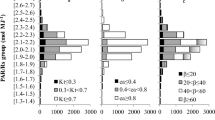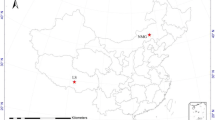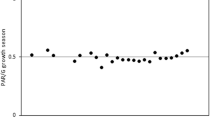Summary
We investigated the ratio of photosynthetically active photon flux (Q p ) to global solar radiation (R s ) at three sites along different altitudes in Naeba Mountain, Japan at various temporal scales based on 3 years measurement data (1999–2001). The lowest values of the ratio ever reported were found for all sites on both an hourly and a daily scale. A similar slight diurnal pattern was found for all sites based on the monthly mean hourly values of the ratio. However, different sites exhibited different seasonal courses. Statistically significant altitude dependencies were found for the hourly Q p /R s under both clear and cloudy weather conditions (t-test, P < 0.001). For clear weather conditions, the hourly Q p /R s exhibited an increasing trend with altitude at an average rate of 3.6% per km. The increasing rate was more noticeable below 900 m (8.8% per km) than above (0.7% per km). The inverse trend was found for hourly Q p /R s with the altitude under cloudy weather conditions. The hourly Q p /R s decreased from 550 m to 1500 m at a rate of 1.8% per km. Again, a major decrease occurred below 900 m, which had the rate of 4.2% per km, compared with 0.2% per km over 900 m. Although the same tendencies were noted for daily Q p /R s , under clear sky conditions, they were not as statistically significant as the hourly counterpart (t-test, P < 0.021). The increasing rate of Q p /R s at this scale under clear weather conditions was near that of the hourly rate, but below the 900 m rate was reduced to near half of the hourly rate (4.7% per km). And the rate over 900 m increased to 2.7% per km. On the other hand, statistically significant altitude effect was noted for the daily under cloudy weather conditions (t-test, P < 0.002). A rapidly decreasing rate was found for it along the altitude gradient. The reason was due to the large decreasing rate below 900 m (12.4% per km). But again similar to the hourly Q p /R s , a very small decreasing rate of daily Q p /R s was found over 900 m under cloudy weather conditions. These results suggest the necessity of considering the altitude dependency of Q p /R s in future studies.
Similar content being viewed by others
References
I Alados L Alados-Arboledas (1999) ArticleTitleDirect and diffuse photosynthetically active radiation: measurements and modelling Agric Forest Meteorol 93 27–38 Occurrence Handle10.1016/S0168-1923(98)00107-5
L Alados-Arboledas FJ Olmo I Alados M Perez (2000) ArticleTitleParametric models to estimate photosynthetically active radiation in Spain Agric Forest Meteorol 101 187–201 Occurrence Handle10.1016/S0168-1923(99)00163-X
RE Bird C Riordan (1986) ArticleTitleSimple solar spectral model for direct and diffuse irradiance on horizontal and tilted planes at the Earth’s surface for cloudless atmospheres J Climate Appl Meteor 25 87–97 Occurrence Handle10.1175/1520-0450(1986)025<0087:SSSMFD>2.0.CO;2
J Garrison G Adler (1990) ArticleTitleEstimation of precipitable water over the United States for application to the division of solar radiation into its direct and diffuse components Solar Energy 44 225–241 Occurrence Handle10.1016/0038-092X(90)90151-2
JA Gonzalez J Calbo (2002) ArticleTitleModelled and measured ratio of PAR to global radiation under cloudless skies Agric Forest Meteorol 110 319–325 Occurrence Handle10.1016/S0168-1923(01)00291-X
C Gueymard (1989) ArticleTitleAn atmospheric transmittance model for the clear sky solar beam, diffuse and global photosynthetically active radiation Agric Forest Meteorol 45 215–229 Occurrence Handle10.1016/0168-1923(89)90045-2
Gueymard C (1994a) Simple model of the atmospheric radiative transfer of sunshine, version 2 (SMARTS2): algorithms description and performance assessment. Florida Solar Energy Report, FSEC-PF-271-94
C Gueymard (1994b) ArticleTitleAnalysis of monthly average atmospheric precipitable water and turbidity in Canada and the northern United States Solar Energy 53 57–71 Occurrence Handle10.1016/S0038-092X(94)90606-8
TA Howell DW Meek JL Hatfield (1983) ArticleTitleRelationship of photosynthetically active radiation to shortwave radiation in the San Joaquin Valley Agric Meteorol 28 157–175 Occurrence Handle10.1016/0002-1571(83)90005-5
M Iqbal (1983) An introduction to solar radiation NumberInSeriesXVIII Academic Press New York 390
CP Jacovides FS Timvios G Papaioannou DN Asimakopoulos CM Theofilou (2004) ArticleTitleRatio of PAR to broadband solar radiation measured in Cyprus Agric Forest Meteorol 121 135–140 Occurrence Handle10.1016/j.agrformet.2003.10.001
CP Jacovides G Timvios DN Asimakopoulos CM Theofilou S Pashiardes (2003) ArticleTitleGlobal photosynthetically active radiation and its relationship with global solar radiation in the Eastern Mediterranean basin Theor Appl Climatol 74 227–233 Occurrence Handle10.1007/s00704-002-0685-5
Y Kakubari (1977) Beech forests in the Naeba Mountains: distribution of primary productivity along the altitudinal gradient J Shidei T Kira (Eds) Primary productivity of Japanese forest SeriesTitleJIBP Synthesis NumberInSeries16 Univ. of Tokyo Press Tokyo 201–221
KJ McCree (1972) ArticleTitleTest of current definitions of photosynthetically active radiation against leaf photosynthesis data Agric Meteorol 10 443–453 Occurrence Handle10.1016/0002-1571(72)90045-3
M Mottus J Ross M Sulev (2001) ArticleTitleExperimental study of ratio PAR to direct integral solar radiation under cloudless conditions Agric Forest Meteorol 109 161–170 Occurrence Handle10.1016/S0168-1923(01)00269-6
M Naramoto (2003) ArticleTitlePhotosynthetic response to sun fleck and its importance to carbon gain in different light environments of a Fagus crenata forest floor in the Naeba Mountains Bulletin of the Shizuoka University Forests 27 13–80
Romero J, Wehrli C, Frohlich C (1996) Maintenance of the world radiometric reference. In: Int. Pyrheliometric Comparison IPC VIII 25 September– 13 October 1995, Results Symp. Swiss Meteorol. Inst. Davos and Zürich, Working Rep No. 188, pp 49–51
J Ross M Sulev (2000) ArticleTitleSources of errors in measurements of PAR Agric Forest Meteorol 100 103–125 Occurrence Handle10.1016/S0168-1923(99)00144-6
SO Udo TO Aro (1999) ArticleTitleGlobal PAR related to global solar radiation for central Nigeria Agric Forest Meteorol 97 21–31 Occurrence Handle10.1016/S0168-1923(99)00055-6
Wang Q, Tenhunen J, Schmidt M, Kolcun O, Droesler M (2006) A model to estimate global radiation in complex terrain. Bound-Layer Meteor (in press)
Author information
Authors and Affiliations
Rights and permissions
About this article
Cite this article
Wang, Q., Kakubari, Y., Kubota, M. et al. Variation on PAR to global solar radiation ratio along altitude gradient in Naeba Mountain. Theor. Appl. Climatol. 87, 239–253 (2007). https://doi.org/10.1007/s00704-005-0220-6
Received:
Revised:
Accepted:
Published:
Issue Date:
DOI: https://doi.org/10.1007/s00704-005-0220-6




